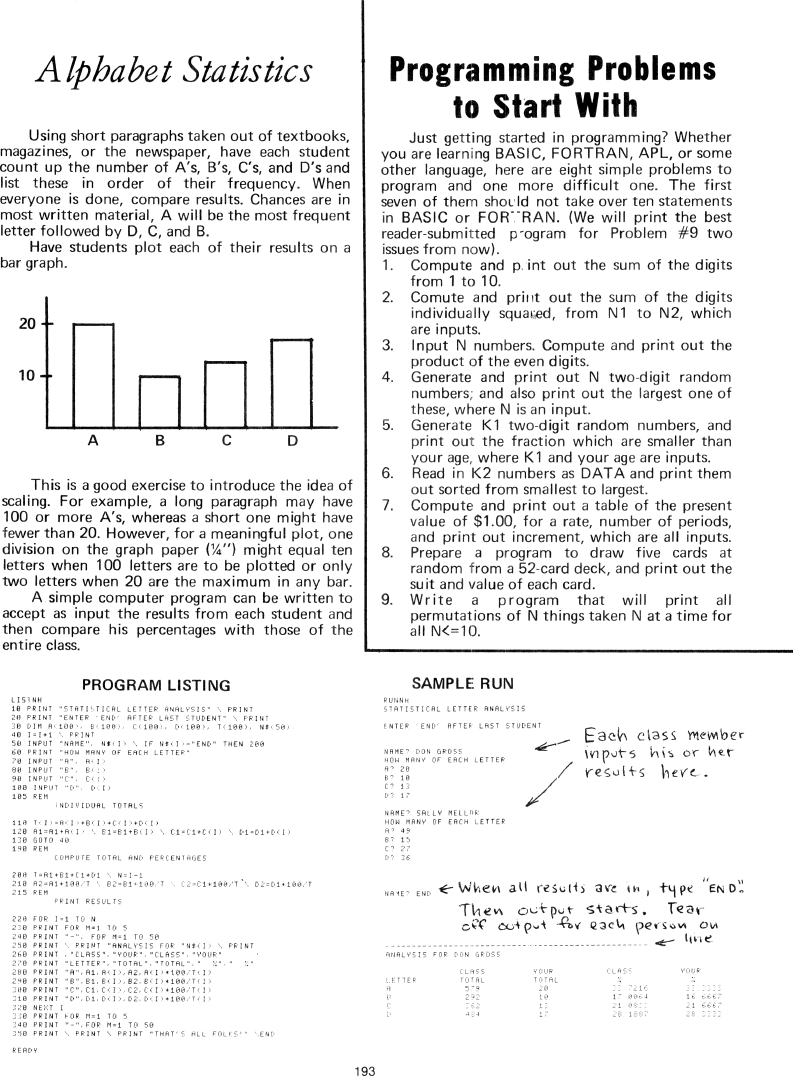The Best of Creative Computing Volume 1 (published 1976)
Alphabet Statistics (Statistical letter analysis)

Alphabet Statistics
Using short paragraphs taken out of textbooks,
magazines, or the newspaper, have each student
count up the number of A's, B's, C's, and D's and
list these in order of their frequency. When
everyone is done, compare results. Chances are in
most written material, A will be the most frequent
letter followed by D, C, and B.
Have students plot each of their results on a
bar graph.
20
10
A B C D
This is a good exercise to introduce the idea of
scaling. For example, a long paragraph may have
100 or more A's, whereas a short one might have
fewer than 20. However, for a meaningful plot, one
division on the graph paper (1/4") might equal ten
letters when 100 letters are to be plotted or only
two letters when 20 are the maximum in any bar.
A simple computer program can be written to
accept as input the results from each student and
then compare his percentages with those of the
entire class.
PROGRAM LISTING
(ISTNN
10 PRINT *STATISTICAL LETTER ANALYSIS* / PRINT
20 PRINT *ENTER 'END' AFTER LAST STUDENT* \ PRINT
30 DIN A< 100 > B< 100 > C< 100 > T< 100 > N!<50>
40 I*1*1 / PRINT
50 INPUT *NAME*. N!< I > / IF N!< I >* END* THEN 200
60 PRINT *HOW MANY OF EACH LETTER*
70 INPUT *A*, A< I >
80 INPUT *B*, B< I >
90 INPUT *C*, C< I >
100 INPUT * D*, D< I >
105 REM
INDIVIDUAL TOTALS
110 T< I > *A< I > *B< I > /*C< I >*D< I >
120 A1* A1 *A< I> / B1*B< 1 > /CI* C1 C< 1 > / D1*DI*D< I >
130 GOTO 40
190 REN
COMPUTE TOTAL AND< PERCENTAGES
200 T *AI*BI*CI*DI /N*I-I
210 A2*AI*100/T / 02*01*100/1 / C2*C1*100/T /02*D1*100/T
215 REM
PRINT RESULTS
220 FOR I*1 TO N
230 PRINT FOR M*1 IO 5
240 PRINT FOR M*1 T0 50
250 PRINT / PRINT *ANALYSIS FOR *N!< I > / PRINT
260 PRINT, CLA*, *YOUR*, *CLASS*, *YOUR*
270 PRINT *LETTER*, *TOTAL*, * %*,* %*
280 PRINT *A*, A1, A<1>, A2, A<1>*100/T<1>
290 PRINT *B*, B1, B<1>, B2, B<1>*100/T<1>
300 PRINT *C*, C1, C<1>, C2, C<1>*100/T<1>
310 PRINT *D*, D1, D<1>, D2, D<1>*100/T<1>
320 NEXT I
330 PRINT FOR M 1 TO 5
340 PRINT FOR M 1 T0 50
250 PRINT / PRINT \ PRINT *THAT'S ALLFOLKS* /END
READY
Programming Problems
to Start With
Just getting started in programming? Whether
you are learning BASIC, FORTRAN, APL, or some
other language, here are eight simple problems to
program and one more difficult one. The first
seven of them should not take over ten statements
in BASIC or FORTRAN. (We will print the best
reader-submitted program for Problem #9 two
issues from now).
1. Compute and point out the sum of the digits
from 1 to 10.
2. Comute and print out the sum of the digits
individually squaced, from N1 to N2, which
are inputs.
3. Input N numbers. Compute and print out the
product of the even digits.
4. Generate and print out N two-digit random
numbers; and also print out the largest one of
these, where N is an input.
5. Generate K1 two-digit random numbers, and
print out the fraction which are smaller than
your age, where K1 and your age are inputs.
6. Read in K2 numbers as DATA and print them
out sorted from smallest to largest.
7. Compute and print out a table of the present
value of $1.00, for a rate, number of periods,
and print out increment, which are all inputs.
0. Prepare a program to draw five cards at
random from a 52-card deck, and print out the
suit and value of each card.
9. Write a program that will print all
permutations of N things taken N at a time for
all N<=10.
SAMPLE RUN
RUNNN
STATISTIACAL LETTER ANALYSIS
ENTER 'END' AFTER LAST STUDENT
Each class member
Inputs his or her
results here
NAME? DON GROSS
HOW MANY OF EACH LETTER
A? 20
B? 10
C? 13
D? 17
NAME? SALLY MELLAR
HOW MANY OF EACH LETTER
A? 49
B? 15
C? 27
D? 26
NAME? END
When all results are in, type "END".
Then outout starts. Tear
Off out put for each person on line
ANALYSIS FOR DON GROSS
LETTER CLASS YOUR TOTAL CLASS YOUR%
A 579 20 22 7216 23 2222
B 292 10 17 0066 16 6667
C 262 12 21 003 21 6667
D 404 17 20 1097 20 2222


